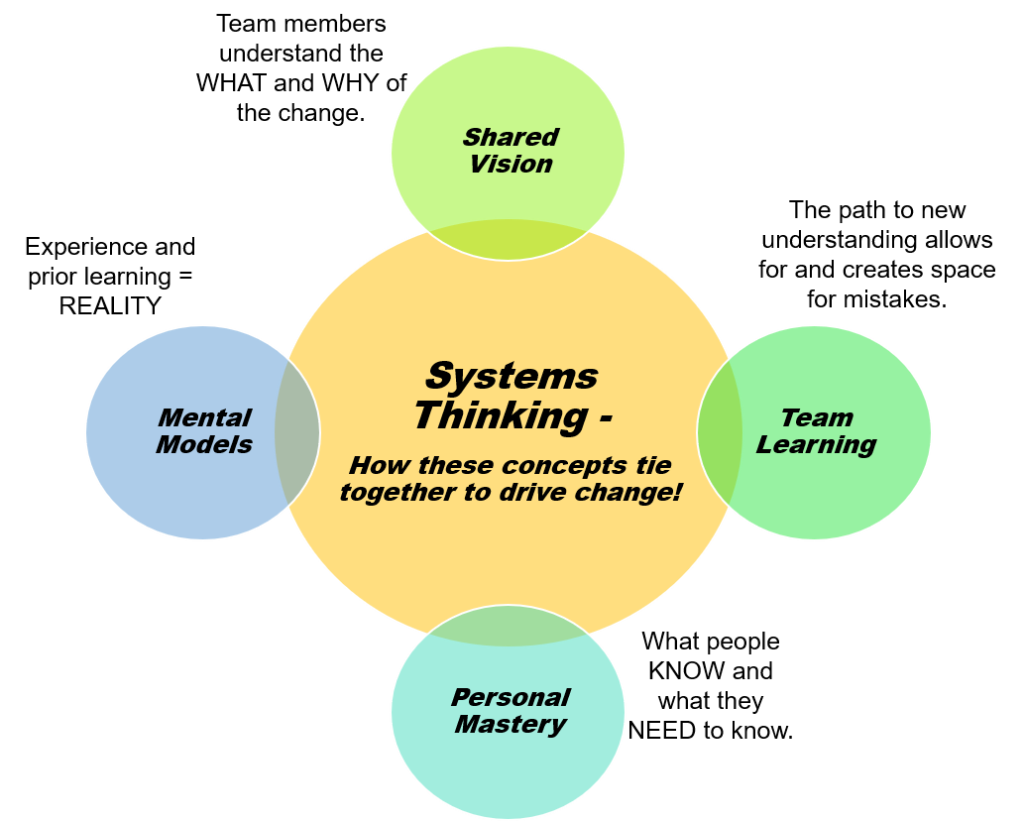by Beth Hedger
In Part 1, I discussed Peter Senge’s five disciplines of a learning organization and reviewed the challenges, opportunities, and unique communication aspects of leading a change initiative with remote teams. In Part 2, I will explore ways these five disciplines contribute to leading change in remote teams.
When leading remote teams through change, it can be helpful to shift your thinking (and your teams!) from the mindset of “being charged with implementing change” to “applying learning principles to organizational problems.” Whether the change involves a new technology, products and services, or organizational realignments, your team, the organization, and you will need to apply new behaviors, new mindsets, and new skillsets.
Applying Peter Senge’s five disciplines can prepare remote teams for change and inform how to structure communications within the team and your organization. The diagram below shows how Shared Vision, Team Learning, Personal Mastery, and Mental Models are aligned together through Systems Thinking. Let’s take a look at each of Peter Senge’s five disciplines and review several quick tips to get you started.

The first discipline to consider is Shared Vision. Shared vision is a road map that describes the desired future state, what your team needs to understand about the future state, and why the future state is necessary.
Quick tips:
- Make vision documents accessible through file shares.
- Incorporate vision summaries in relevant presentations to illustrate how the vision relates to future work.
- Review pieces of the vision during team meetings and show how the vision connects to initiatives and work streams.
- Ask each team member to describe how they have applied or personalized the vision to their work.
The second discipline to consider is Team Learning: Often during change initiatives, teams need to develop new processes and communicate those to the broader organization. Work with your team to create an environment where trial and error is welcome, mistakes become lessons learned, and assigning blame is minimized.
Quick tips:
- Brainstorm when and how to capture and apply lessons learned.
- Reward people who identify issues and offer solutions.
- Adjust plans and communications to incorporate lessons learned.
The third discipline to consider is Personal Mastery. Along with creating a team culture that welcomes learning through mistakes, each team member brings strengths and will encounter personal learning opportunities throughout the change process.
Quick tips:
- Reward team members for identifying and correcting blind spots.
- Leave time in meetings or project planning sessions to allow for candid sharing and encourage a culture that enables asking for help.
- Discuss with your team how to identify learning opportunities.
The fourth discipline is Mental Models. We each have constructed our view of the world based on past experience. When resistance to change occurs, it often is related to how people experienced life and constructed their understanding of reality.
Quick tips:
- Be alert for concepts or words and ask clarifying questions to uncover what people believe or understand.
- Create a glossary of terms or list of frequently asked questions that are captured throughout the change initiative and updated regularly.
- Evaluate policies, processes, and procedures and document opportunities to revise and clarify existing documents or develop new ones.
The fifth discipline (and the focus of Peter Senge’s book) is Systems Thinking: In change initiatives, teams and leaders need to be able to see the inter-relatedness of an organization’s ways of doing things, personal beliefs, experience, and where there may be gaps that hinder the change process.
Quick tips:
- Get support from colleagues! As a remote team leader, plan reflection time with a trusted colleague to debrief how the team is responding and performing along the change journey.
- Schedule regular check-ins to assess how the change is impacting individual team members.
- Apply the five disciplines as a guide to probing for pain points or to identify successful strategies.
Change is challenging! But with a plan in place, solid guiding principles (such as Peter Senge’s learning organization model) and regular communication, remote teams, just like co-located teams, can successfully tackle almost any complex change initiative.
